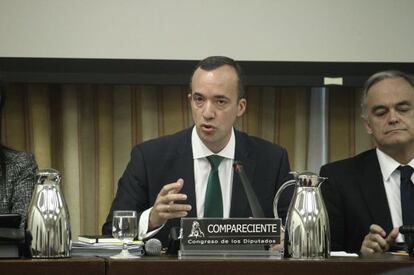Government footage provides no clues to migrants’ death by drowning
Opposition had demanded that Interior Ministry clear up Civil Guard’s role in Ceuta tragedy

The government on Wednesday showed Congress audio and video footage aimed at clearing up why 15 migrants drowned near Ceuta while trying to make it into Spanish territory on February 6.
But despite the expectation among the opposition parties, which had pressured the Popular Party (PP) for this congressional appearance, the material failed to provide any clues as to who ordered rubber bullets to be fired at the sub-Saharans to repel them from the border fence. Neither did the footage show how the migrants drowned, or whether the bullets triggered a panic that drove them into the sea.
Francisco Martínez, the number two official at the Interior Ministry, answered Socialists’ questions regarding who gave the order to shoot with a vague “the orders on the ground are given by the operatives [before that he had mentioned the lieutenant in charge] but political officials support them and I think that the vast majority of citizens understand [the need for them].”
Martínez had selected his footage carefully, showing only half a dozen clips out of 96 existing ones. He did not provide video images of the drownings even though one security camera is pointed at the beach (footage from this camera was shown, but from a later time). The deputy minister insisted on underscoring the migrants’ violent attitude, showed shots of the Moroccan police throwing rocks at them, and insisted that the drownings occurred in Moroccan waters. “There is no tone of alarm in the conversations among the Civil Guards because [the migrants] were not drowning in front of them. They died in Moroccan waters,” he said.
The deputy minister
insisted on underscoring the migrants’ violent attitude
The European Union had also asked Spain for explanations regarding the incident shortly after it happened, and Madrid retorted with a petition for more funds to help police the border of what constitutes Europe’s southernmost point. Spain has two exclave cities in North Africa: Ceuta and Melilla, which are the goal for thousands of Africans trying to reach Europe.
Migratory pressure on both cities has grown exponentially in recent months. Last year, a total of 1,074 undocumented migrants made it into Melilla, according to sources in the Interior Ministry. In the two-and-a-half months that have elapsed since the beginning of 2014, more than 1,600 have crossed successfully, representing a sharp increase.
Tu suscripción se está usando en otro dispositivo
¿Quieres añadir otro usuario a tu suscripción?
Si continúas leyendo en este dispositivo, no se podrá leer en el otro.
FlechaTu suscripción se está usando en otro dispositivo y solo puedes acceder a EL PAÍS desde un dispositivo a la vez.
Si quieres compartir tu cuenta, cambia tu suscripción a la modalidad Premium, así podrás añadir otro usuario. Cada uno accederá con su propia cuenta de email, lo que os permitirá personalizar vuestra experiencia en EL PAÍS.
¿Tienes una suscripción de empresa? Accede aquí para contratar más cuentas.
En el caso de no saber quién está usando tu cuenta, te recomendamos cambiar tu contraseña aquí.
Si decides continuar compartiendo tu cuenta, este mensaje se mostrará en tu dispositivo y en el de la otra persona que está usando tu cuenta de forma indefinida, afectando a tu experiencia de lectura. Puedes consultar aquí los términos y condiciones de la suscripción digital.
More information
Últimas noticias
Mexico seeks to shore up its defenses following US incursion in Venezuela
Hope gives way to uncertainty among Venezuelan exiles in the US after Maduro’s capture
Cubans look to Venezuela fearfully after Trump’s incursion: ‘We could be next’
The operation in Venezuela to capture Maduro threatens to widen the cracks in the MAGA movement
Most viewed
- Alain Aspect, Nobel laureate in physics: ‘Einstein was so smart that he would have had to recognize quantum entanglement’
- Alvin Hellerstein, a 92-year-old judge appointed by Bill Clinton, to preside over Maduro’s trial in New York
- Gilles Lipovetsky: ‘If you want to live better and fall in love, take Prozac, don’t look to philosophy’
- Cuba confirms death of 32 of its citizens in the US attack against Venezuela
- Why oil has been at the center of Venezuela-US conflicts for decades








































